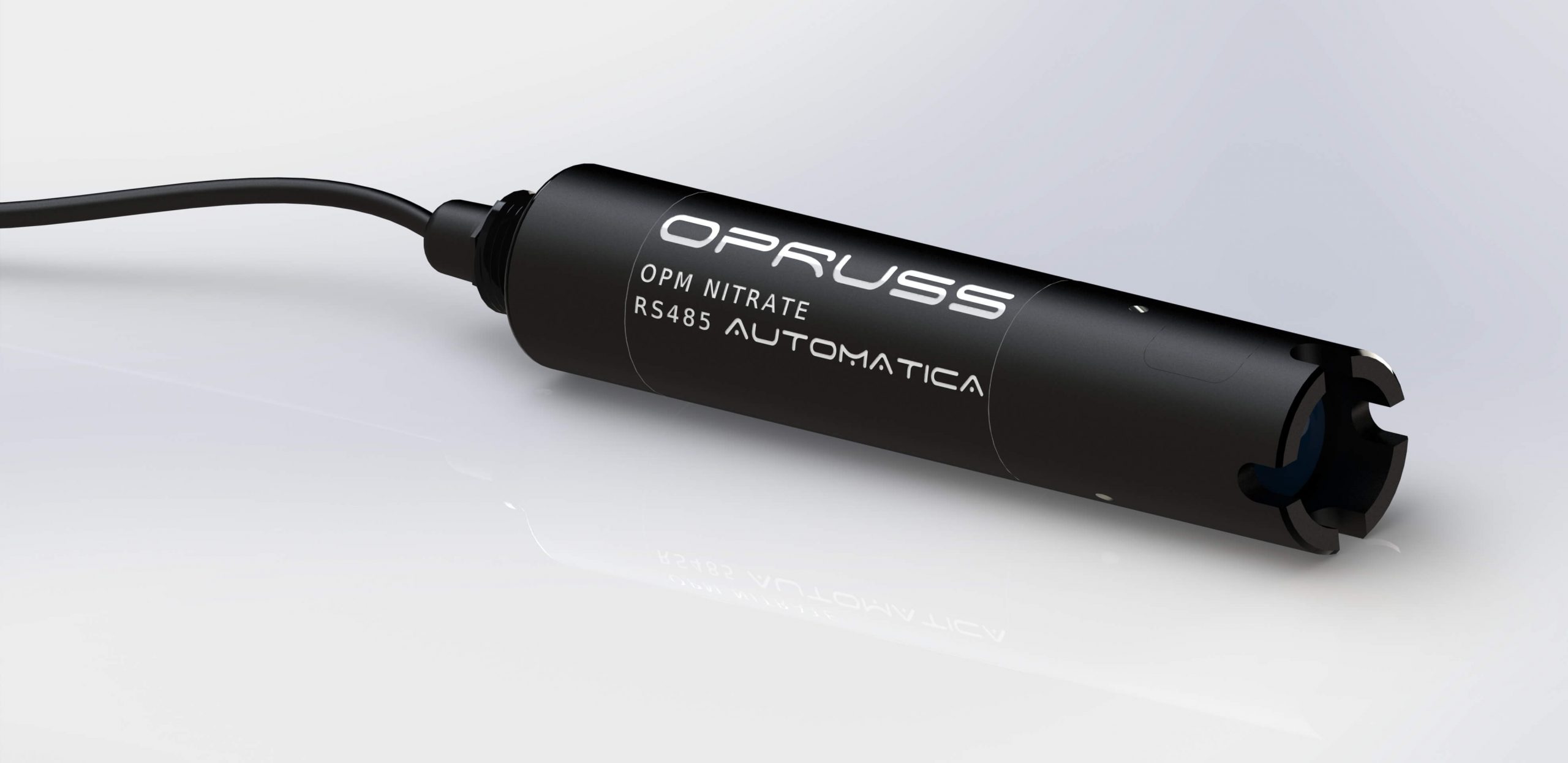OPM NITRATE
Sensor for measuring Nitrate ions in aqueous medium

- RS485 Digital signal output
- Plug and play design
- Ultra-rigid cable for on-field use
- Enabled with remote accessed calibration
- Non-corrosive POM PEEK shell
- Built in interference cancellation
- Tested for perfection
- Advanced diagnostics enabled system
- Equipped with improved Selective Ions
- Accurate and repeatable readings
- Shock proof sensor aperture
- Adaptability to several water matrices
NITRATE (NO3)
Nitrates are the most water soluble of all salts, and play a huge part in nitrate pollution. Inorganic nitrates are formed by bacteria and are an important component of agricultural soil. The OPM Nitrate ISE has a specific high performance combination non-refillable, deterioration resistant electrode. However, the replaceable module of ISE allows you to simply discard the used membrane module, and replace it with a new one.
A liquid membrane ion selective electrode develops a voltage due to the ion exchange that occurs between the solution and the polymer membrane that contains organic ion exchange resin. When the ionic strength of the solution is fixed by the addition of ISA, the voltage is proportional to the concentration of free ions in solution
Limits:
According to EPA the limits for nitrates are Permissible: 100 mg/lit Desirable: 45 mg/l
Chemical Stability:
Nitrates are soluble compounds containing nitrogen and oxygen. Nitrate salts are very soluble. Nitrate is a nitrogen oxoanion formed by loss of a proton from nitric acid. Principal species present at pH 7.3. It is a conjugate base of a nitric acid.Nitrates, inorganic, aqueous solution is a liquid which is readily ignited when in contact with organic materials. It is noncombustible but will accelerate the burning of combustible materials.

Sources:
1. Runoff or seepage from fertilized agricultural lands
Recently, agriculture is recognized as a major source of water pollution, which is also the most difficult to reduce. One of the most dangerous is nitrogen and phosphorus leaching from fields to groundwater and surface water because higher amounts of these nutrients gets used in natural and mineral fertilizers compared to plant requirements or supplied in adverse conditions.
2. Municipal and industrial waste water
Water pollution has many sources. The most polluting of them are the city sewage and industrial waste discharged into the rivers. Industrial waste is defined as waste generated by manufacturing or industrial processes. The types of industrial waste generated include cafeteria garbage, dirt and gravel, masonry and concrete, scrap metals, trash, oil, solvents, chemicals, weed grass and trees, wood and scrap lumber, and similar wastes. Industrial solid waste which may be solid, liquid or gases held in containers.
3. Refuse dumps
Land, water and air pollution in the vicinity are primarily caused by illegal dumping. The chemicals and non-biodegradable materials in the waste affect the waterways by contaminating groundwater and soil.
4. Animal feedlots and livestock facility
Water and soil pollution from agriculture occur due to residues of used pesticides, emission of ammonium, methane or sulfide from livestock production and livestock manures.
5. Septic tanks and private sewage disposal systems
Private sewage system deals with waste water not served by the mains sewer. These systems are used to treat and dispose of relatively small volumes of wastewater, usually from houses and businesses located in suburban and rural locations not served by a centralised public sewer system.
Septic systems treat wastewater from household plumbing fixtures including toilet, shower, laundry, etc through both natural and technological processes, typically beginning with solids settling in a septic tank, and ending with wastewater treatment in the soil through the drain field.
6. Urban drainage and decaying plant debris
Plant debris like bracts, leaves and twigs decomposes if there is an excess of moisture which causes fermentation and decaying due to which number of pollutants gets released in the environment.
7. Geologic formations and direction of ground water flow
Groundwater moves slowly through an aquifer means porous rock, and unlike the surface water of a stream, it has a lot of contact with the surrounding rocks or sediment. Over time, all groundwater gradually has more and more material dissolved within it as it remains in contact with the aquifer.
8. Manure lagoons
Manure lagoon is a man-made outdoor earthen basin filled with animal waste that undergoes anaerobic respiration. These manure lagoon systems are designed to manage and treat refuse created by concentrated animal feeding operations. Waste lagoons very often gets leaks and spills, as they are often uncovered, unlined and separated from waterways by narrow embankments that can overflow or get collapsed. Spills can be highly damaging to the environment.
Features
- Exact and reliable real-time measurement
- Long-term stable measurement
- No additional conditioning reagents necessary
- OPM Fluoride is an all inclusive system requiring no reagents, or mechanical devices for performing.
- The core is ion selective electrode with a mono-crystal sensing element specially developed from maintenance free solid state reference system.
- Specially developed anti fouling aperture components reduce the ability of surface depositions, also comes with a non-porous electrode to reduce surface depositions
- Features a smart built in compensation of error due to temperature and potential noise
- Outputs sensor diagnostics data to closely and continuously track field performance without the need of physical access
- Comes with a easy plug and play design that is robust enough for industrial application
Installation methods
Medium immersed
- Sites with challenges like a distant medium source from the point of controller mount, this method of installation can be chosen.
- The analyser being constantly in contact with the medium helps the analyser to never face a dry-off situation
Extractive
- Where the sample enters and exits the system like a standard stationed measuring device. Usually avoids the Constantine medium matrix as the sample with variating quality flows through the device rather than a partially stagnant volume of medium. Sample extraction accessory is required for this type
OPM Nitrate
Send download link to:
